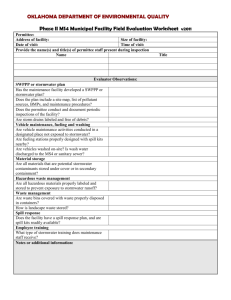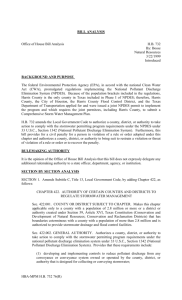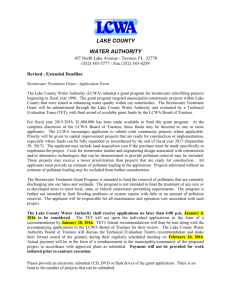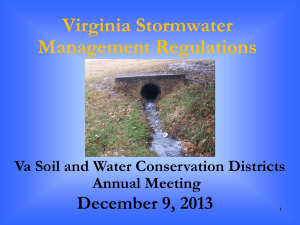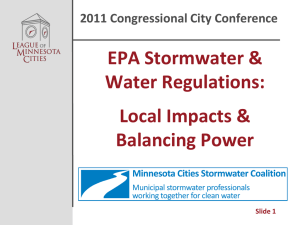TELR_PEAIP_memo_final
advertisement
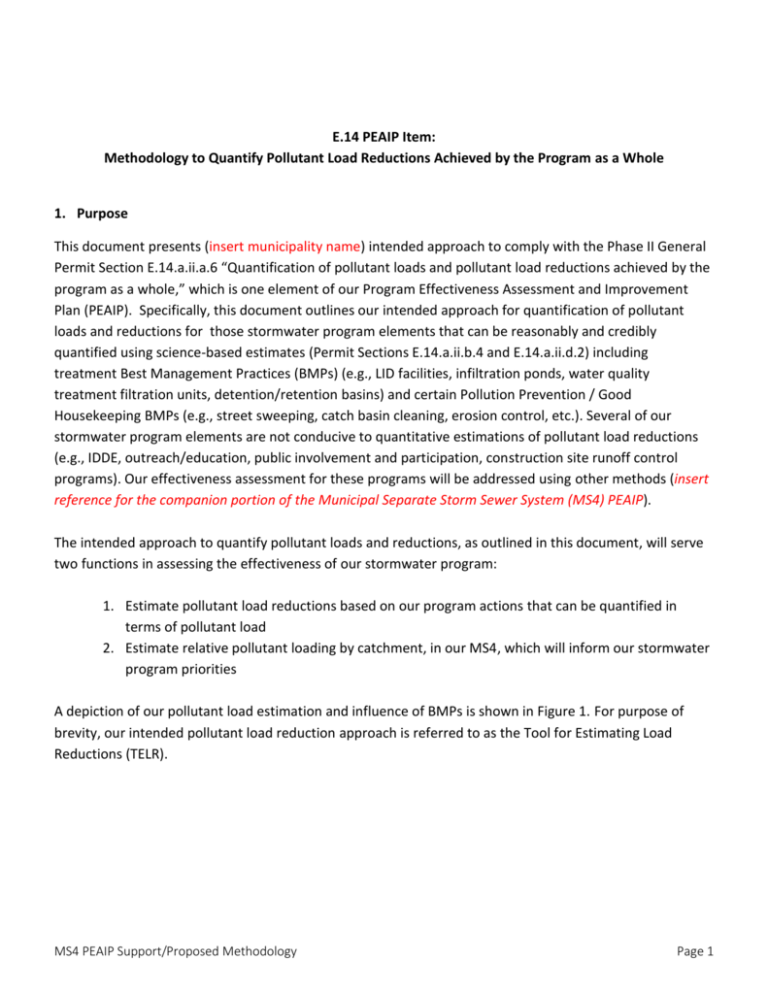
E.14 PEAIP Item: Methodology to Quantify Pollutant Load Reductions Achieved by the Program as a Whole 1. Purpose This document presents (insert municipality name) intended approach to comply with the Phase II General Permit Section E.14.a.ii.a.6 “Quantification of pollutant loads and pollutant load reductions achieved by the program as a whole,” which is one element of our Program Effectiveness Assessment and Improvement Plan (PEAIP). Specifically, this document outlines our intended approach for quantification of pollutant loads and reductions for those stormwater program elements that can be reasonably and credibly quantified using science-based estimates (Permit Sections E.14.a.ii.b.4 and E.14.a.ii.d.2) including treatment Best Management Practices (BMPs) (e.g., LID facilities, infiltration ponds, water quality treatment filtration units, detention/retention basins) and certain Pollution Prevention / Good Housekeeping BMPs (e.g., street sweeping, catch basin cleaning, erosion control, etc.). Several of our stormwater program elements are not conducive to quantitative estimations of pollutant load reductions (e.g., IDDE, outreach/education, public involvement and participation, construction site runoff control programs). Our effectiveness assessment for these programs will be addressed using other methods (insert reference for the companion portion of the Municipal Separate Storm Sewer System (MS4) PEAIP). The intended approach to quantify pollutant loads and reductions, as outlined in this document, will serve two functions in assessing the effectiveness of our stormwater program: 1. Estimate pollutant load reductions based on our program actions that can be quantified in terms of pollutant load 2. Estimate relative pollutant loading by catchment, in our MS4, which will inform our stormwater program priorities A depiction of our pollutant load estimation and influence of BMPs is shown in Figure 1. For purpose of brevity, our intended pollutant load reduction approach is referred to as the Tool for Estimating Load Reductions (TELR). MS4 PEAIP Support/Proposed Methodology Page 1 Figure 1. The TELR approach quantifies pollutant loading on an urban (MS4) catchment basis, ranks all MS4 catchments by pollutant loading rates to the receiving waters. Subsequent re-quantification of pollutant loading resulting from recent stormwater program actions it repeated annually. 2. Background 2.1 Relationship to Phase II Stormwater NPDES Permit Requirements The intended TELR approach supports compliance with the Phase II MS4 Municipal Permit’s PEAIP requirements (E.14). Specifically, the TELR methodology will address the following requirements: Identify assessment methods to quantitatively assess BMP performance at reducing pollutant loads (E.14.a.ii.d) Identify a strategy to gauge the effectiveness of prioritized BMPs and program implementation as a whole (E.14.a.i.) Prepare a PEAIP that includes: o quantification of pollutant loads and pollutant load reduction achieved by the program as a whole (E.14.a.ii.a.6); o assessment of pollutant source reductions achieved by individual BMPs (E.14.a.ii.a.5); o assessment of BMP and program effectiveness in terms of Outcome level 4 – pollutant load reductions (E.14.a.ii.b.4); MS4 PEAIP Support/Proposed Methodology Page 2 2.2 Use of TELR results TELR will output estimates of average annual pollutant loads and load reductions associated with stormwater improvement actions using a spatial, catchment-scale analysis. The TELR methodology will build upon similar work developed in the Lake Tahoe Region to create a user-friendly, transparent and scientifically-credible tool to estimate pollutant loads. The pollutant load estimations, catchment delineations and other analytical components of TELR are not ground-breaking or complex. Mapping products and associated pollutant load information from TELR can be used iteratively to guide priorities and quantify the load reduction achieved by the program over time. Rather than attempting to model, track and evaluate multiple pollutants, the TELR methodology will use credible and effective proxies (i.e., stormwater volumes and total suspended solids (TSS) to create a ranking of MS4 catchments in terms of relative potential risk to the receiving water. TELR will be used to generate two pollutant load scenarios for an urban catchment; a “Land Use Load” and a “Current Load”. Land Use Load: A catchment land use load is the baseline estimated average annual load without any stormwater program actions or improvements. The land use load is based solely on land use distribution and unmodified hydrologic connectivity of the catchment to the receiving waters. Current Load: The current load is the estimate of the average annual pollutant load with the implementation and assumed effectiveness of stormwater program actions including source control and structural BMP implementation in the catchment for the respective year evaluated. LAND USE LOAD – CURRENT LOAD = LOAD REDUCTION The difference between the Land Use Load and Current Load is the estimated Load Reduction achieved as a result of the stormwater program for the year and catchment of interest. Each year the current load value for each catchment area can be normalized (e.g. acre feet per acre per year; termed Current Loading Rate) and integrated and ranked for all catchments within the municipality. The catchments with the highest Current Loading Rate per unit area are the catchments with the potential greatest risk to receiving water quality for the current year. The results of this prioritization are mapped to simplify communication of priority catchments to managers, funders, regulators, etc. Figure 2 illustrates example catchments shaded purple and red where stormwater improvements and associated maintenance should be prioritized to achieve and sustain reductions in stormwater pollutant loading to the receiving waters over time. MS4 PEAIP Support/Proposed Methodology Page 3 Figure 2. MS4 catchment pollutant loading results of ranking are mapped to clearly illustrate the catchments with the greatest potential risk per unit area to the receiving water quality (i.e., purple and red catchments) and are therefore priorities for stormwater program BMPs. The TELR approach will be developed and implemented using readily available data, including the results of BMP performance assessments. Using performance assessment information, the annual estimated pollutant load reductions are revised and the information used to reevaluate our stormwater program priorities each year. Stormwater managers can then aim to implement stormwater program BMPs that will result in changing a high risk catchment to a lower risk catchment. The implementation of this standardized and consistent process can be used to adaptively manage the annual priorities of a stormwater program over time. The continued estimation and reporting of Land Use and Current Loads annually allows tracking of the water quality benefits of the entire MS4 program over time. Figure 3 provides an example of how we MS4 PEAIP Support/Proposed Methodology Page 4 intend to use graphic summaries to track and communicate program load reduction progress (i.e. program effectiveness) over time. Figure 3. Example MS4 program reporting formats. Using TELR results, the aggregation of the load reductions estimated for each catchment is used to document the estimated MS4 pollutant load reduction each year. The development of the TELR approach will be developed with involvement from the Central Coast Regional Water Quality Control Board (Central Coast Water Board), the Low Impact Development Initiative (LIDI), 2NDNATURE, LLC and regional MS4 stakeholders. 2.3 Relationship of TELR to Long-term Receiving Water Quality Data Phase II Stormwater NPDES Permittees must manage their MS4 to protect and improve receiving water quality. Ultimately, receiving water quality data can provide information to assess whether water quality standards and other receiving water beneficial uses have been achieved. One of the greatest difficulties in MS4 PEAIP Support/Proposed Methodology Page 5 stormwater management is our collective inability to confidently link the municipal BMPs to water quality improvements in the receiving water. This is due to the fact that detecting the benefits of MS4 stormwater quality BMPs can be masked due to (1) natural variability, (2) error associated with sampling and/or, potentially, the (3) signal in the water quality variability due to other sources beyond the MS4 contributions. Permittees need an ability to assess their own actions (i.e., within the MS4) in terms of water quality improvements and they need to be able to do so on a temporal scale that aligns with their needs to identify and prioritize stormwater quality actions, verify the relative effectiveness of their actions, provide some standardized accounting of the benefits of their actions, and adaptively manage their program on yearly time scales. TELR will be an easy to use and standardized tool that can provide this information in useable formats to meet these needs. Stormwater Program Managers cannot make appropriate programmatic decisions based solely on receiving water quality data on annual time intervals. Rather, a long-term, consistent and well executed water quality monitoring program in strategic locations could be used to verify the hypothesis that effective stormwater BMPs will result in measurable decreasing trends in receiving water pollutant concentrations and loads, beyond natural variability and sampling error. 2.4 Relationship of TELR to the California Stormwater Quality Association’s (CASQA) Program Effectiveness Assessment and Improvement Plan (PEAIP) Framework CASQA recently developed a PEAIP Framework to support development of MS4 PEAIPs. In many respects, the intended TELR approach is consistent and supports the CASQA framework. For example, the use of information concerning pollutant source contributions and MS4 contributions is consistent between both approaches to estimate pollutant loading. However, there is a key difference between the two approaches: The CASQA PEAIP Framework includes identification of the highest priority “Pollutants of Concern” (POCs) based on available knowledge, data, etc. (e.g., 303(d) listings, TMDLs) and subsequent identification and prioritization of BMPs based on these POCs. In comparison, the TELR approach is based on the premise that stormwater volume and TSS are reliable proxies for the majority of pollutant types and that knowledge of the greatest potential risk due to pollutant loading is sufficient to direct the majority of stormwater program actions and priorities. Focus on water quality improvement actions in catchments with the current highest pollutant loading rates (i.e., highest volume or TSS loading rates) will result in program management actions that reduce all related urban derived pollutant generation and delivery from stormwater to receiving waters, including those of interest due to 303(d) listing or TMDLs. TELR assumes that urban pollutant fate and transport for nearly all urban derived pollutants can be reasonably represented by stormwater volumes and sediment loads. If stormwater runoff volumes are effectively treated at the source, stormwater pollutant loading to receiving waters will be minimized. Pervious or impervious surface with relatively higher accumulations of sediment are also likely to contain relatively higher mass loads of other urban pollutants (e.g., the typical pollutants of concern (POCs): metals, MS4 PEAIP Support/Proposed Methodology Page 6 oils/greases, bacteria, pesticides/herbicides, nutrients). While all catchment prioritization ranking may not exactly match the accurate prioritization for every individual POC; our hypothesis is that in the majority of instances, the TELR approach will credibly inform program priorities and action. This decreases the complexity of the modelling effort as well as the cost while still providing high-value information to inform short- and long-term program priorities. A detailed description of the intended TELR approach is provided in Section 3 below. 3. Tool for Estimating Load Reductions (TELR) Approach The TELR approach includes use the MS4 map products and BMP inventory to support estimation of MS4 catchment volume and pollutant loads. Section 3 provides detail related to the TELR approach: Section 3.1 describes the desired functions (i.e. product output) for estimating pollutant loads and associated load reductions, Section 3.2 describes the process to evaluate existing hydrologic and pollutant load models to meet our desired functions and the decision to develop a separate approach and tool (i.e. TELR), and Section 3.3 provides detail regarding the TELR approach including how our MS4 mapping will be integrated with the pollutant load/reduction approach to result in desired products and information. 3. 1 Desired Function for Estimating Pollutant Loads and Reductions The approach to estimate our MS4 pollutant loading and reductions is guided by six fundamental objectives: 1. Create credible pollutant load estimations: The approach must generate scientifically defensible and relatively accurate estimations of average annual loading for the MS4 by catchment(s). 2. Focus modelling on pollutants that are representative of urban impacts: The inclusion of several different pollutant types will not improve the ability of stormwater managers to select and implement effective actions to protect receiving water quality. In fact, we argue more pollutants over complicates the process of modelling, thereby distracting resources and focus from implementation of effective actions. Because all urban pollutants, with perhaps the exception of trash, are associated with stormwater runoff volumes and/or TSS, using pollutant loading estimates of these two parameters significantly reduces cost and complexity while providing reliable information to guide the implementation and management of our stormwater quality improvement program. Use of urban pollutant proxies should not negate source control BMPs that target specific pollutants but rather help identify where those actions might be most cost-effective. 3. Focus analysis on factors that most influence pollutant loading: The approach should focus on the key drivers (e.g., land use, hydrologic connectivity, BMP presence and sizing) that influence average MS4 PEAIP Support/Proposed Methodology Page 7 annual urban pollutant loading. Additionally, these model parameters should be readily available to municipal stormwater managers (e.g., public data such as GIS layers, precipitation data, BMP inventory etc.). 4. Sensitivity to water quality improvement actions: The approach must be sensitive to pollutant loading reductions from stormwater Best Management Practices (BMPs) and isolate the variability in urban pollutant loading from natural climatic variability. 5. Appropriate to the entire MS4: The method should be applicable and the results scalable to the entire MS4. The results should (1) inform meaningful spatial comparisons to identify catchments with the greatest current pollutant loading to the receiving waters and (2) allow program wide documentation of pollutant load reduction estimates over time. 6. Ease of initial set-up and on-going use: The approach must be easy to use by the Permittee and include clear user guidance, a complete and functional data management structure, and automatically generate results in directly usable formats. The approach should be publically available (i.e., non-proprietary) for use. Results must be reported in useable and simple formats that inform program decisions; satisfy annual reporting requirements to the Central Coast Water Board; and, track water quality improvement progress of the MS4 stormwater program. 3.2 Evaluation of Existing Models to Meet Desired Functions A review of a number of available public and proprietary urban hydrology and pollutant load model(s) (HSPF, SWMM, STEPL, SWC, PLRM, HEC HMS, Watershed Treatment Model, etc.) indicated that no existing available models achieve all of the fundamental objectives stated in 3.1. Therefore, a customized approach and model is being created to achieve the stated objectives above. The customized approach and desired objectives will be achieved by the Tool for Estimating Load Reductions (TELR). While no one model provides the necessary framework to achieve the desired objectives, review and testing of three specific model platforms will inform our hydrology and pollutant loading as appropriate. (i.e. Spreadsheet Tool for Estimating Pollutant Loads (STEPL: TetraTech 2011, version 4.1), Pollutant Load Reduction Model (PLRM v2; nhc et al. 2014) and National Stormwater Calculator (SWC), (EPA/600/R-13/085c, 2014i) 3.3 The Tool for Estimating Load Reductions (TELR) Approach The information below summarizes how TELR will achieve the desired functionality to estimate urban catchment pollutant loads, utilize the results to prioritize catchments for stormwater improvement actions, and estimate the annual load reduction benefits of the actions implemented under a municipal stormwater program. 3.3.1 Credible Pollutant Load Estimation The model will integrate the most sensitive parameters driving existing urban water quality models in a manner that minimizes user complexity yet preserves the relative technical accuracy and rigor necessary to MS4 PEAIP Support/Proposed Methodology Page 8 generate relatively reliable stormwater pollutant loading estimates to inform management decisions and account for progress using average annual pollutant load reductions as the unit of measure. TELR will run on regionally representative precipitation using a probability-based integration approach of daily rainfall and runoff intensities. Precipitation inputs will be held constant between Land Use and Current Load scenarios to document the estimate load reductions due to BMP implementation and performance. The water quality benefits of source control and small scale structural BMPs have a level of performance that aligns with the density of implementation by land use, literature values regarding performance, PCR design requirements, and/or annual effectiveness assessments. Larger scale centralized BMP performance includes an event volume accounting and treatment performance also informed by existing literature and annual effectiveness assessments. While the absolute estimates of all models will vary, TELR will be developed to generate catchment results that will generally correlate with estimates using more complex modelling platforms. The intent is to have confidence that the priorities and/or relative load reductions identified by TELR are relatively accurate, thereby providing the correct information to guide effective stormwater management. A transparent documentation and supporting template of the fundamental assumptions and how user inputs are integrated TELR to generate average annual loads will be created and readily available. 3.3.2 Modelled Pollutants The pollutants selected for modeling are stormwater volumes and sediment loads. These pollutants are assumed to serve as reliable collective proxies to guide prioritization of catchments and implementation of improvements for the majority of urban pollutants known to impact receiving water quality. The catchments identified with the highest loading rates are, in most instances, the greatest potential threat of most urban derived pollutants delivered to receiving waters. Stormwater Volume: If stormwater program actions are effective, stormwater volumes discharging from the MS4 to receiving waters will be substantially reduced or eliminated, even during the highest intensity storms. Eliminating stormwater discharge equates to removal of urban pollutants associated with these wet weather discharges and concomitant reduction of pollutant loading to the receiving waters. Sediment: Sediment, reported as total suspended solids (TSS), is a common and well researched stormwater quality parameter. There is extensive literature and national datasets documenting the ranges of TSS concentrations in land use and mixed urban runoff. While TSS loading from urban catchments may or may not exceed regulatory thresholds, there is a well-documented range of concentrations emanating from urban lands that are maintained from good to poor condition. In addition, stormwater improvement actions implemented to reduce sources of TSS or treat TSS loads entrained in stormwater are, in many instances, also effective at reducing the concentrations and loads of other common urban pollutants. TSS has been documented to correlate to pathogens, trace MS4 PEAIP Support/Proposed Methodology Page 9 metals, hydrocarbons, and phosphorus in urban runoff (Chen and Chang 2014; National Stormwater Quality Database v1.1). Processes commonly used to treat urban stormwater via structural BMPs infiltration, particle capture and media filtration - are equally effective at treating most hydrophobic pollutants. Hydrophilic pollutant load reductions (i.e., nitrate) are assumed to occur concurrently with effective stormwater volume reductions. 3.3.3 Use of Model Inputs that Influence Pollutant Loading TELR will use regionally relevant precipitation data, local soils, slope, and land use to inform a probability distribution approach to estimate average annual catchment volumes. All of the required inputs will be readily available to stormwater managers through a variety of information sources including MS4 mapping products and online source. Pollutant generation by land use will be further refined by the defined relative condition of the individual catchment’s land use. The MS4 catchment/outfall mapping products include a complete delineation of the MS4 into unique drainage catchments and a number of associated catchment attributes (i.e. catchment area, impervious area, land use distribution, hydrologic connectivity, etc.). These spatial attributes are important to conduct to pollutant load estimates for each catchment within our MS4. MS4 mapping conducted as part of the IDDE requirements (Section E.9) will be used to support our TELR approach including: • Location of outfalls • Catchment drainage area delineations • Land use contributions and imperviousness • Location of water bodies receiving direct discharges from outfalls • Hydrologic connectivity of each catchment to the receiving waters The pollutant load reductions associated with the presence and condition of water quality improvement BMPs will be directly integrated into catchment load estimates. Clear user guidance, automated functions and an innovative data management system will simplify the process required to generate representative model inputs. 3.3.4 Sensitivity to water quality improvement actions Precipitation inputs will be held constant for all load estimation scenarios to eliminate any result variability due to climatic differences, and therefore isolate the load reduction estimates attributed to stormwater quality improvement actions. Land Use Loads will be calculated to estimate catchment loading without any BMPs in place. Catchment Current Loads for each water year will include the estimated benefits of source control programs (e.g., street sweeping, erosion control), LID implementation on urban land uses, dispersed and centralized structural BMPs (e.g., infiltration features, dry basins, bioretention facilities). MS4 PEAIP Support/Proposed Methodology Page 10 Each year, Current Loads are subtracted from Land Use Loads to estimate the load reduction associated with the implementation and maintenance of the stormwater program actions within each catchment. 3.3.5 Appropriateness to the MS4 The municipality’s MS4 consists of many individual urban catchments. The customized model will simplify user workflow and provide clear user guidance for stormwater managers so they can utilize readily available data to populate necessary model inputs. A customized user input template coupled with automated data reporting formats will be created to simply translate inputs into pollutant load results for all catchments within the MS4. The results will presented be in graphical formats to immediately inform program decisions and track progress over time. A comprehensive data management structure and annual process will minimize data entry year after year, allowing stormwater managers to focus on estimating current pollutant loads where improvements were implemented. The difference between the pollutant loads estimated without the implementation of stormwater program actions (i.e. Land Use Load) and the Current Load as a result of the stormwater program provides a quantitative measure to track annual MS4 program progress over time (see Figure 3). 3.3.6 Ease of initial set up and on-going use We have leveraged Phase II Permit MS4 mapping requirements to develop specific catchment attributes that inform the pollutant load model estimates. For example, catchment delineation, hydrologic connectivity and land use distribution are all direct inputs to TELR. The initial set up will require the Permitee to populate TELR with the required data for all MS4 catchments. However, once TELR is populated with existing mapping and water quality BMP data, on-going use will be simple and relatively low maintenance. The only changes year after year will be mainly focused on catchments where water quality improvement actions are prioritized and implemented. i Spreadsheet Tool for Estimating Pollutant Loads (STEPL) is a macro-enabled MS Excel spreadsheet tool developed by EPA Region 5 and TetraTech (TetraTech 2011, version 4.1). The STEPL hydrology model is similar to the desired approach necessary to meet the custom model objectives, though some modifications to incorporate a probabilistic approach are necessary. STEPL uses an empirical approach to estimate runoff based on surface type and static land use runoff pollutant concentrations to estimate loads. Average annual results include volume and load estimates by catchment and land use, and the benefits of a variety of BMP types, but does not incorporate BMP condition or larger scale structural BMPs. A large amount of complexity within STEPL is not necessary to achieve objectives and will be removed. STEPL graphically summarizes load reduction estimates between scenarios. Multiple catchments with multiple scenarios can be saved within a single MS Excel file; though the data management functionality is limited when estimates are generated in Excel files. i The Pollutant Load Reduction Model (PLRM) is a customized platform (PLRM v2; nhc et al. 2014) that is used by the Lake Tahoe TMDL to estimate average annual volume and pollutant load reductions as a result of stormwater improvements. PLRM integrates the SWMM (EPA, 2010) continuous hydrology model with a customized water quality module that estimates land use pollutant concentrations as a function of land use condition. Large scale structural BMPs are explicitly incorporated and modelled as water quality treatment structures at the outfall of a catchment. The customized model will incorporate the land use condition and structural modelling approach of PLRM. In addition, PLRM is used to conduct a number of sensitivity tests to MS4 PEAIP Support/Proposed Methodology Page 11 isolate the most sensitive parameters driving urban pollutant loads to guide custom model development. Model calibration will include comparisons to PLRM volume and sediment estimates. Data management is limited to scenario evaluations for a single catchment, a feature that will be greatly improved by the new model. i National Stormwater Calculator (SWC), developed by the EPA (EPA/600/R-13/085c, 2014) is an online tool used to estimate runoff via the continuous simulation SWMM (EPA, 2010) platform. The National SWC has a user-friendly interface to input precipitation, land cover, climate change and the implementation of LID improvements on a catchment scale. The user friendly formats will be leveraged for the custom tool. SWC lacks a number of critical features to isolate the effectiveness of the stormwater program actions. In addition, data management within the platform is limited to two load reduction estimates, required an external data management process to achieve custom tool objectives. MS4 PEAIP Support/Proposed Methodology Page 12
